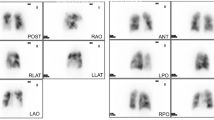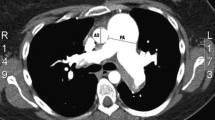Abstract
Objectives
Chronic thromboembolic pulmonary hypertension (CTEPH) can be treated with balloon pulmonary angioplasty (BPA) in inoperable patients. Sensitive non-invasive imaging methods are missing to detect treatment response after a single BPA treatment session. Therefore, the aim of this study was to measure treatment response after a single BPA session using cardio-pulmonary MRI.
Materials and methods
Overall, 29 patients with CTEPH were examined with cardio-pulmonary MRI before and 62 days after their initial BPA session. Pulmonary blood flow (PBF), first-pass bolus kinetic parameters, and biventricular mass and function were determined. Multiple linear regression analysis was implemented to estimate the relationship of PBF change in the treated lobe with treatment change of full width at half maximum (FWHM), cardiac output (CO), ventricular mass index (VMI), pulmonary transit time (PTT) and PBF change in the non-treated lobes. Paired Wilcoxon rank sum test and Spearman rho correlation were used.
Results
After BPA regional PBF increased in the treated lobe (p < 0.0001) as well as in non-treated lobes (p = 0.015). PBF treatment changes in the treated lobe were significantly larger compared with the non-treated lobes (p = 0.0049). Change in NT proBNP, MRI-derived mean pulmonary artery pressure (mPAP), PTT, FWHM, right ventricular (RV) ejection fraction, RV stroke volume, CO, VMI and PBF in the non-treated lobes correlated with PBF change in the treated lobe (p < 0.05). PBF changes in the treated lobe were independently predicted by PTT as well as PBF change in the non-treated lobes.
Conclusion
Cardio-pulmonary MRI detects and quantifies treatment response after a single BPA treatment session.
Key Points
• Two months after BPA regional parenchymal pulmonary perfusion (PBF) increased in the total lung parenchyma (p = 0.005), the treated lobes (p < 0.0001) and non-treated lobes (p = 0.015).
• The PBF treatment changes in the treated lobe were significantly larger than in the non-treated lobes (p = 0.0049).
• Change in NT proBNP, MRI-derived mean pulmonary artery pressure, pulmonary transit time, full width at half maximum, right ventricular (RV) ejection fraction, RV stroke volume, cardiac output, ventricular mass index and PBF in the non-treated lobes correlated with PBF change in the treated lobe (p < 0.05).


Similar content being viewed by others
Abbreviations
- 6MWD:
-
Six-minute walking distance
- BPA:
-
Balloon pulmonary angioplasty
- BSA:
-
Body surface area
- CO:
-
Cardiac output
- CTEPH:
-
Chronic thromboembolic pulmonary hypertension
- DCE:
-
Dynamic contrast enhanced
- EDV:
-
End-diastolic volume
- EF:
-
Ejection fraction
- ESV:
-
End-systolic volume
- FWHM:
-
Full width at half maximum
- LV:
-
Left ventricular
- mPAP:
-
Mean pulmonary artery pressure
- NT-proBNP:
-
N-terminal pro B-type natriuretic peptide
- NYHA FC:
-
New York Heart Association functional classification
- PBF:
-
Pulmonary blood flow
- PE:
-
Pulmonary embolism
- PEA:
-
Pulmonary endarterectomy
- PH:
-
Pulmonary hypertension
- PTT:
-
Pulmonary transit time
- PVR:
-
Pulmonary vascular resistance
- RHC:
-
Right-sided heart catheterization
- RV:
-
Right ventricular
- SV:
-
Stroke volume
- TTP:
-
Time to peak
- TWIST:
-
Time-resolved angiography with stochastic trajectories
- VMI:
-
Ventricular mass index
References
Olsson KM, Wiedenroth CB, Kamp JC et al (2017) Balloon pulmonary angioplasty for inoperable patients with chronic thromboembolic pulmonary hypertension: the initial German experience. Eur Respir J 49:1602409. https://doi.org/10.1183/13993003.02409-2016
Lang IM, Madani M (2014) Update on chronic thromboembolic pulmonary hypertension. Circulation 130:508–518. https://doi.org/10.1161/CIRCULATIONAHA.114.009309
Hoeper MM, Madani MM, Nakanishi N, Meyer B, Cebotari S, Rubin LJ (2014) Chronic thromboembolic pulmonary hypertension. Lancet Respir Med 2:573–582. https://doi.org/10.1016/S2213-2600(14)70089-X
Kim NH, Delcroix M, Jenkins DP et al (2013) Chronic thromboembolic pulmonary hypertension. J Am Coll Cardiol 62:D92–D99. https://doi.org/10.1016/j.jacc.2013.10.024
Pepke-Zaba J, Delcroix M, Lang I et al (2011) Chronic thromboembolic pulmonary hypertension (CTEPH): results from an international prospective registry. Circulation 124:1973–1981. https://doi.org/10.1161/CIRCULATIONAHA.110.015008
Hoeper MM (2016) Residual Pulmonary hypertension after pulmonary endarterectomy: the fog is clearing. https://doi.org/10.1161/CIRCULATIONAHA.116.022595
Hinrichs JB, Renne J, Hoeper MM, Olsson KM, Wacker FK, Meyer BC (2016) Balloon pulmonary angioplasty: applicability of C-Arm CT for procedure guidance. Eur Radiol 26:4064–4071. https://doi.org/10.1007/s00330-016-4280-z
Sato H, Ota H, Sugimura K et al (2016) Balloon pulmonary angioplasty improves biventricular functions and pulmonary flow in chronic thromboembolic pulmonary hypertension. Circ J 80:1470–1477. https://doi.org/10.1253/circj.CJ-15-1187
Ogo T, Fukuda T, Tsuji A et al (2017) Efficacy and safety of balloon pulmonary angioplasty for chronic thromboembolic pulmonary hypertension guided by cone-beam computed tomography and electrocardiogram-gated area detector computed tomography. Eur J Radiol 89:270–276. https://doi.org/10.1016/j.ejrad.2016.12.013
Mizoguchi H, Ogawa A, Munemasa M, Mikouchi H, Ito H, Matsubara H (2012) Refined balloon pulmonary angioplasty for inoperable patients with chronic thromboembolic pulmonary hypertension. Circ Cardiovasc Interv 5:748–755. https://doi.org/10.1161/CIRCINTERVENTIONS.112.971077
Mayer E, Jenkins D, Lindner J et al (2011) Surgical management and outcome of patients with chronic thromboembolic pulmonary hypertension: Results from an international prospective registry. J Thorac Cardiovasc Surg 141:702–710. https://doi.org/10.1016/j.jtcvs.2010.11.024
Jenkins DP, Madani M, Mayer E et al (2013) Surgical treatment of chronic thromboembolic pulmonary hypertension. Eur Respir J 41:735–742. https://doi.org/10.1183/09031936.00058112
Shimura N, Kataoka M, Inami T et al (2015) Additional percutaneous transluminal pulmonary angioplasty for residual or recurrent pulmonary hypertension after pulmonary endarterectomy. Int J Cardiol 183C:138–142. https://doi.org/10.1016/j.ijcard.2015.01.034
Inami T, Kataoka M, Shimura N et al (2014) Pressure-wire-guided percutaneous transluminal pulmonary angioplasty: a breakthrough in catheter-interventional therapy for chronic thromboembolic pulmonary hypertension. JACC Cardiovasc Interv 7:1297–1306. https://doi.org/10.1016/j.jcin.2014.06.010
Champion HC, Michelakis ED, Hassoun PM (2009) Comprehensive invasive and noninvasive approach to the right ventricle-pulmonary circulation unit: state of the art and clinical and research implications. Circulation 120:992–1007. https://doi.org/10.1161/CIRCULATIONAHA.106.674028
Roik M, Wretowski D, Łabyk A et al (2016) Refined balloon pulmonary angioplasty driven by combined assessment of intra-arterial anatomy and physiology - Multimodal approach to treated lesions in patients with non-operable distal chronic thromboembolic pulmonary hypertension - Technique, safety and efficacy of 50 consecutive angioplasties. Int J Cardiol 203:228–235. https://doi.org/10.1016/j.ijcard.2015.10.116
Maschke SK, Renne J, Werncke T et al (2017) Chronic thromboembolic pulmonary hypertension: Evaluation of 2D-perfusion angiography in patients who undergo balloon pulmonary angioplasty. Eur Radiol 27:4264–4270. https://doi.org/10.1007/s00330-017-4806-z
Roik M, Wretowski D, Łabyk A et al (2017) Refined balloon pulmonary angioplasty-A therapeutic option in very elderly patients with chronic thromboembolic pulmonary hypertension. J Interv Cardiol. https://doi.org/10.1111/joic.12387
Leuchte HH, El Nounou M, Tuerpe JC et al (2007) N-terminal pro-brain natriuretic peptide and renal insufficiency as predictors of mortality in pulmonary hypertension. Chest 131:402–409. https://doi.org/10.1378/chest.06-1758
Nagaya N, Nishikimi T, Uematsu M et al (2000) Plasma brain natriuretic peptide as a prognostic indicator in patients with primary pulmonary hypertension. Circulation 102:865–870
Simonneau G, D'Armini AM, Ghofrani HA et al (2016) Predictors of long-term outcomes in patients treated with riociguat for chronic thromboembolic pulmonary hypertension: data from the CHEST-2 open-label, randomised, long-term extension trial. Lancet Respir Med 4:372–380. https://doi.org/10.1016/S2213-2600(16)30022-4
Suntharalingam J, Goldsmith K, Toshner M et al (2007) Role of NT-proBNP and 6MWD in chronic thromboembolic pulmonary hypertension. Respir Med 101:2254–2262. https://doi.org/10.1016/j.rmed.2007.06.027
American College of Cardiology Foundation Task Force on Expert Consensus Documents, Hundley WG, Bluemke DA et al (2010) ACCF/ACR/AHA/NASCI/SCMR 2010 expert consensus document on cardiovascular magnetic resonance: a report of the American College of Cardiology Foundation Task Force on Expert Consensus Documents. J Am Coll Cardiol 55:2614–2662
Kreitner KF, Kunz RP, Ley S et al (2007) Chronic thromboembolic pulmonary hypertension—assessment by magnetic resonance imaging. Eur Radiol 17:11–21. https://doi.org/10.1007/s00330-006-0327-x
Peacock AJ, Vonk Noordegraaf A(2013) Cardiac magnetic resonance imaging in pulmonary arterial hypertension. Eur Respir Rev 22:526–534. https://doi.org/10.1183/09059180.00006313
Jenkins D, Mayer E, Screaton N, Madani M (2012) State-of-the-art chronic thromboembolic pulmonary hypertension diagnosis and management. Eur Respir Rev 21:32–39. https://doi.org/10.1183/09059180.00009211
Schoenfeld C, Cebotari S, Hinrichs J et al (2016) MR imaging-derived regional pulmonary parenchymal perfusion and cardiac function for monitoring patients with chronic thromboembolic pulmonary hypertension before and after pulmonary endarterectomy. Radiology 279:925–934. https://doi.org/10.1148/radiol.2015150765
Galiè N, Humbert M, Vachiery JL et al (2016) 2015 ESC/ERS Guidelines for the diagnosis and treatment of pulmonary hypertension: The Joint Task Force for the Diagnosis and Treatment of Pulmonary Hypertension of the European Society of Cardiology (ESC) and the European Respiratory Society (ERS): Endorsed by: Association for European Paediatric and Congenital Cardiology (AEPC), International Society for Heart and Lung Transplantation (ISHLT). Eur Heart J 37:67–119. https://doi.org/10.1093/eurheartj/ehv317
Hinrichs JB, Marquardt S, von Falck C et al (2016) Comparison of C-arm computed tomography and digital subtraction angiography in patients with chronic thromboembolic pulmonary hypertension. Cardiovasc Intervent Radiol 39:53–63. https://doi.org/10.1007/s00270-015-1090-7
Rajaram S, Swift AJ, Telfer A et al (2013) 3D contrast-enhanced lung perfusion MRI is an effective screening tool for chronic thromboembolic pulmonary hypertension: results from the ASPIRE Registry. Thorax 68:677–678. https://doi.org/10.1136/thoraxjnl-2012-203020
Sourbron S, Dujardin M, Makkat S, Luypaert R (2007) Pixel-by-pixel deconvolution of bolus-tracking data: optimization and implementation. Phys Med Biol 52:429–447. https://doi.org/10.1088/0031-9155/52/2/009
Ingrisch M, Dietrich O, Attenberger UI et al (2010) Quantitative pulmonary perfusion magnetic resonance imaging: influence of temporal resolution and signal-to-noise ratio. Invest Radiol 45:7–14. https://doi.org/10.1097/RLI.0b013e3181bc2d0c
Skrok J, Shehata ML, Mathai S et al (2012) Pulmonary arterial hypertension: MR imaging-derived first-pass bolus kinetic parameters are biomarkers for pulmonary hemodynamics, cardiac function, and ventricular remodeling. Radiology 263:678–687. https://doi.org/10.1148/radiol.12111001
Vogel-Claussen J, Finn JP, Gomes AS et al (2006) Left ventricular papillary muscle mass: relationship to left ventricular mass and volumes by magnetic resonance imaging. J Comput Assist Tomogr 30:426–432
Ryan T, Petrovic O, Dillon JC, Feigenbaum H, Conley MJ, Armstrong WF (1985) An echocardiographic index for separation of right ventricular volume and pressure overload. J Am Coll Cardiol 5:918–927
Vogel-Claussen J, Shehata ML, Lossnitzer D et al (2011) Increased right ventricular septomarginal trabeculation mass is a novel marker for pulmonary hypertension: comparison with ventricular mass index and right ventricular mass. Invest Radiol 46:567–575. https://doi.org/10.1097/RLI.0b013e31821b7041
Swift AJ, Rajaram S, Hurdman J et al (2013) Noninvasive Estimation of PA Pressure, Flow, and Resistance With CMR Imaging: Derivation and Prospective Validation Study From the ASPIRE Registry. JACC Cardiovasc Imaging 6:1036–1047. https://doi.org/10.1016/j.jcmg.2013.01.013
Marra AM, Egenlauf B, Ehlken N et al (2015) Change of right heart size and function by long-term therapy with riociguat in patients with pulmonary arterial hypertension and chronic thromboembolic pulmonary hypertension. Int J Cardiol 195:19–26. https://doi.org/10.1016/j.ijcard.2015.05.105
Yamasaki Y, Nagao M, Kamitani T et al (2016) Clinical impact of left ventricular eccentricity index using cardiac MRI in assessment of right ventricular hemodynamics and myocardial fibrosis in congenital heart disease. Eur Radiol 26:3617–3625. https://doi.org/10.1007/s00330-015-4199-9
Swift AJ, Telfer A, Rajaram S et al (2014) Dynamic contrast-enhanced magnetic resonance imaging in patients with pulmonary arterial hypertension. Pulm Circ 4:61–70. https://doi.org/10.1086/674882
Funding
This study has received funding from the German Center for Lung Research (DZL).
Author information
Authors and Affiliations
Corresponding author
Ethics declarations
Guarantor
The scientific guarantor of this publication is Prof. Dr. Jens Vogel-Claussen.
Conflict of interest
The authors of this manuscript declare no relationships with any companies, whose products or services may be related to the subject matter of the article.
Statistics and biometry
One of the authors has significant statistical expertise.
Informed consent
Written informed consent was obtained from all subjects (patients) in this study.
Ethical approval
Institutional Review Board approval was obtained.
Methodology
• retrospective
• observational
• performed at one institution
Rights and permissions
About this article
Cite this article
Schoenfeld, C., Hinrichs, J.B., Olsson, K.M. et al. Cardio-pulmonary MRI for detection of treatment response after a single BPA treatment session in CTEPH patients. Eur Radiol 29, 1693–1702 (2019). https://doi.org/10.1007/s00330-018-5696-4
Received:
Revised:
Accepted:
Published:
Issue Date:
DOI: https://doi.org/10.1007/s00330-018-5696-4




